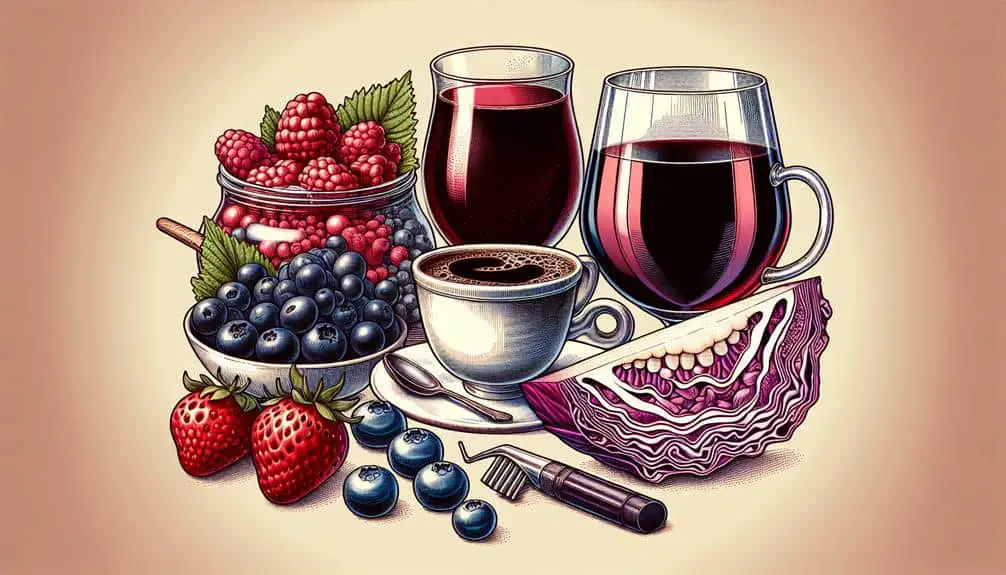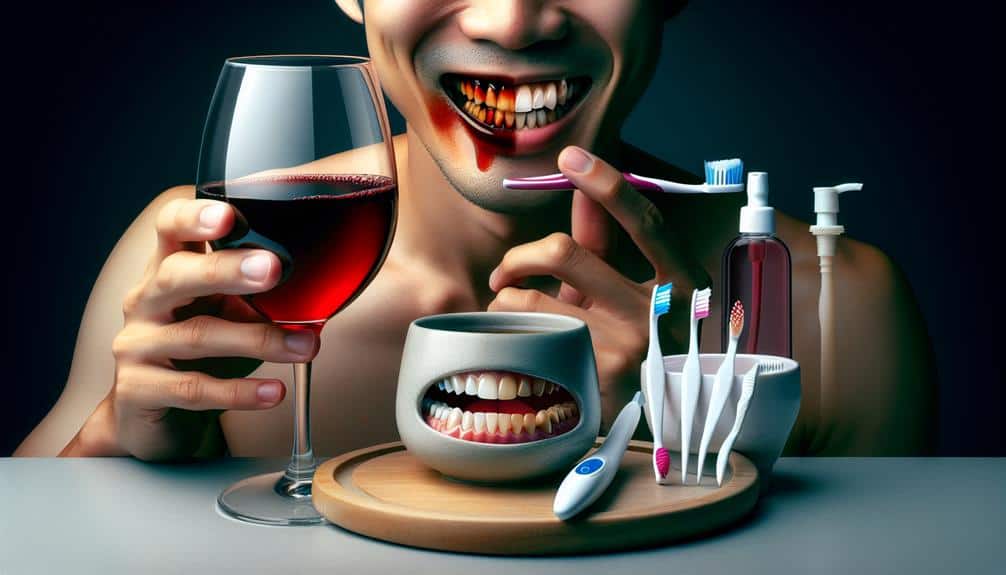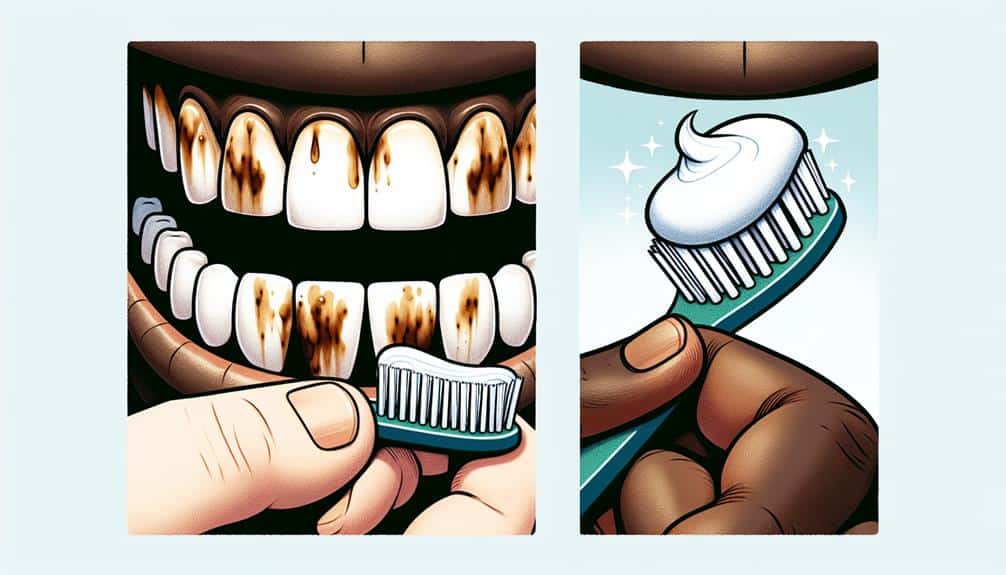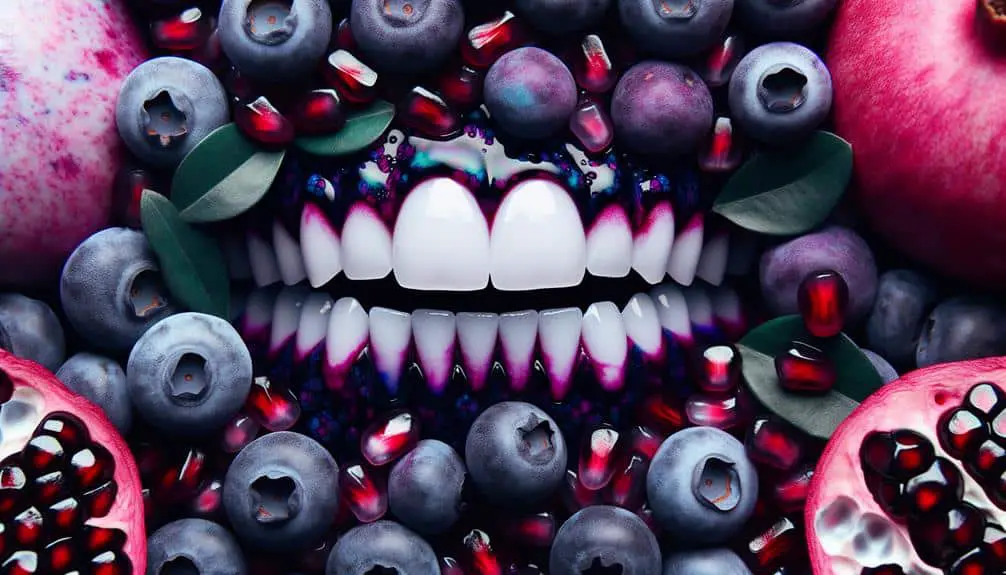Red cabbage, much like coffee and red wine, can contribute to teeth staining as its pigments adhere to enamel, causing discoloration. The anthocyanins in red cabbage juice are known to stain teeth, emphasizing the importance of good oral hygiene practices. To prevent yellowing, rinse your mouth after consuming red cabbage, brush thoroughly, and consider chewing sugar-free gum. Additionally, consuming dairy products can help neutralize acids and protect your teeth. Implementing proper dental care is essential to enjoy the benefits of red cabbage while maintaining a bright smile. A deeper understanding of the impact of pigmented foods awaits.
Key Points
- Red cabbage pigments adhere to enamel, causing tooth discoloration.
- Raw or undercooked red cabbage intensifies staining effects on teeth.
- Anthocyanins in red cabbage juice contribute to teeth yellowing.
- Proper oral hygiene practices can prevent red cabbage-induced teeth staining.
- Regular dental check-ups help maintain teeth free from red cabbage stains.
Impact of Red Cabbage on Teeth
Red cabbage contains pigments that can potentially stain teeth if consumed frequently. These vegetable pigments have the ability to adhere to the surface of tooth enamel, leading to discoloration over time. When red cabbage is consumed raw or in dishes without being adequately cooked, its pigments can more easily bind to the enamel, causing staining. This staining effect isn't only limited to red cabbage but is also applicable to other deeply pigmented foods and beverages.
Maintaining good oral health practices is essential in combating the staining effects of red cabbage. Regular brushing and flossing can help remove the pigments before they've a chance to set in. Additionally, consuming water or crunchy fruits and vegetables after eating red cabbage can help clean the teeth naturally. Visiting the dentist for routine check-ups and cleanings is also vital in preserving dental hygiene and preventing long-term staining caused by red cabbage and other staining agents.
Factors Contributing to Teeth Staining
Among the various factors that contribute to teeth staining, the consumption of certain foods and beverages plays a significant role in discoloring tooth enamel. Coffee stains and wine discoloration are common culprits in this process. Coffee, a popular morning beverage for many, contains chromogens that latch onto the enamel of your teeth, causing them to become yellow over time. The acidity of coffee also erodes tooth enamel, making it more susceptible to staining from other foods and drinks.
Similarly, wine, especially red wine, contains chromogens and tannins that lead to tooth discoloration. The acidity in wine also softens the enamel, allowing pigmented molecules to penetrate it more easily. To prevent or minimize teeth staining from coffee and wine, consider using a straw to reduce direct contact with your teeth or rinsing your mouth with water after consumption. Regular dental check-ups and professional cleanings can also help combat the effects of these staining agents, ensuring a brighter smile.
Red Cabbage Juice and Tooth Discoloration
Consuming various foods and drinks can greatly impact the discoloration of tooth enamel, with red cabbage juice also being a notable contributor to tooth staining. Red cabbage contains natural pigments called anthocyanins, which give it its vibrant color. These pigments can adhere to the enamel of your teeth, leading to stains over time.
To prevent stains caused by red cabbage juice and other pigmented foods and drinks, maintaining good dental hygiene practices is essential. Brushing your teeth at least twice a day with a fluoride toothpaste and flossing daily can help remove plaque buildup and prevent discoloration. Additionally, regular dental check-ups and professional cleanings can aid in keeping your teeth free from stains.
It's important to note that while red cabbage juice may contribute to tooth discoloration, it also offers various health benefits due to its high antioxidant content. By being mindful of your consumption and implementing proper dental care, you can enjoy the nutritional advantages of red cabbage while minimizing the risk of staining your teeth.
Preventing Red Cabbage-Induced Teeth Yellowing
How can you effectively prevent yellowing of your teeth induced by red cabbage consumption? When it comes to preventing discoloration caused by dietary choices like red cabbage, there are several strategies you can implement:
- Drink water: Rinse your mouth with water after consuming red cabbage to help wash away any pigments that could potentially stain your teeth.
- Brush your teeth: Brush your teeth thoroughly after eating red cabbage to remove any residue that could lead to discoloration.
- Chew sugar-free gum: Chewing sugar-free gum can help stimulate saliva production, which aids in neutralizing acids and washing away pigments.
- Consume dairy products: Eating dairy products like cheese or drinking milk after consuming red cabbage can help neutralize acids and protect your teeth from staining.
Dental Care Tips for Stained Teeth
To maintain ideal oral hygiene and combat teeth staining, incorporating appropriate dental care practices into your daily routine is essential. Proper oral hygiene is the cornerstone of maintaining healthy, white teeth. Brushing your teeth at least twice a day with a fluoride toothpaste helps remove surface stains and prevents plaque buildup, which can lead to discoloration.
Flossing daily is important for removing food particles and plaque from between your teeth, areas that a toothbrush can't reach effectively.
Regular dental check-ups and professional cleanings are also important in preventing and addressing teeth staining. Your dentist can recommend suitable teeth whitening treatments to help restore your teeth's natural color and brightness.
Avoiding tobacco products, limiting foods and drinks that stain teeth, like coffee and red wine, and drinking plenty of water can also contribute to maintaining a bright smile.
Frequently Asked Questions
Can Red Cabbage Staining on Teeth Be Easily Removed With Regular Brushing and Flossing?
Regular brushing and flossing are crucial to removing stains. However, for tougher stains like red cabbage, consider professional cleanings or whitening treatments for best results. Prevention through good dental care is always the most effective approach.
Is There a Specific Amount of Red Cabbage Consumption That Leads to Noticeable Teeth Staining?
When it comes to red cabbage consumption and teeth staining, a correlation exists. The more red cabbage consumed, the higher likelihood of noticeable teeth staining. Effective stain removal methods can mitigate the impact of red cabbage consumption on teeth.
Are There Any Alternative Ways to Enjoy Red Cabbage Without Risking Teeth Discoloration?
To enjoy red cabbage without teeth staining, consider consuming it raw in salads or slaws, as cooking can intensify its staining potential. The benefits of red cabbage include antioxidants and vitamins, making it a healthy choice.
How Do Different Cooking Methods of Red Cabbage Affect Its Potential to Stain Teeth?
When cooking red cabbage, various techniques impact its teeth-staining potential. Oxidation during cooking can intensify color. pH levels also play a role; acidic environments increase staining. To protect enamel, consider blanching red cabbage briefly before using in dishes.
Are There Any Natural Remedies or Home Remedies That Can Help Reduce Red Cabbage-Induced Teeth Yellowing?
To reduce teeth yellowing from red cabbage, consider natural remedies like oil pulling or using baking soda. Home solutions such as regular brushing, flossing, and consuming crunchy fruits or vegetables can help prevent stains.



